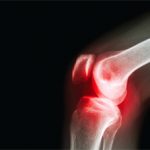Sources of OA Knee Pain
Possible structural sources of knee OA pain include synovial thickening, effusions, bone marrow edema lesions (BMLs) and peri-articular lesions, said Dr. Felson.2-4 These are more easily seen through magnetic resonance imaging (MRI) than X-ray, and both valgus and varus knees may have BMLs, he said. Medial BMLs are related to joint malalignment.5
“These are trauma lesions. What they say is that there is so much stress in a localized area of the knee with that malalignment, they are actually causing damage to the bone. There’s an inflammatory or wound response. OA is like a series of little wounds,” he said. “Cartilage has no pain fibers in it. Cartilage is not a direct generator of pain. The way cartilage might generate pain is indirectly,” such as damaged cartilage releasing microscopic debris that eventually inflames the synovium, he said.
Current & Future Treatments
Acetaminophen, a conditional recommendation in the 2012 ACR recommendations for use of nonpharmacologic and pharmacologic therapies for knee OA pain, has a disappointing average effect size in trials of 0.23.6,7 He still recommends acetaminophen for patients who cannot tolerate non-steroidal anti-inflammatory drugs (NSAIDs), such as seniors. “I want to be as safe as I can be with my patients. But I don’t increase the dose, because there is no evidence to support that. Once they fail occasional acetaminophen, I don’t continue it,” he said.
However, NSAIDs are more effective for knee OA pain relief compared with acetaminophen, with a 0.29 effect size in a 2011 meta-analysis.8 “If acetaminophen fails or doesn’t work well, this is one of your choices,” he said. NSAIDs’ cardiovascular risks, particularly for older patients, vary depending on the drug.9 Oral diclofenac is dangerous, he stressed. “It puts people at increased risk of heart disease, mostly in people who are older whose main mortality risk is heart disease. I don’t use it,” he said. Topical diclofenac is a safer option with no systemic risks. Naproxen does not increase heart disease risk in many studies. “It needs to be in your portfolio of treatment. Not that it doesn’t have other side effects. It does. But with respect to risk of heart disease, it is entirely safe,” he said.
Nabumetone has a comparatively benign risk of upper gastrointestinal bleeding, and celecoxib is also safer option.10 He prefers to prescribe celecoxib at less than 400 mg a day to avoid an increase in heart disease risk.11 Consider topical NSAIDs over oral forms, he said. “Given the inefficacy of acetaminophen, I think these will surpass acetaminophen as a recommendation in the future. They are benign and work, although not terribly well, but mainly for hand OA and knee OA.”

